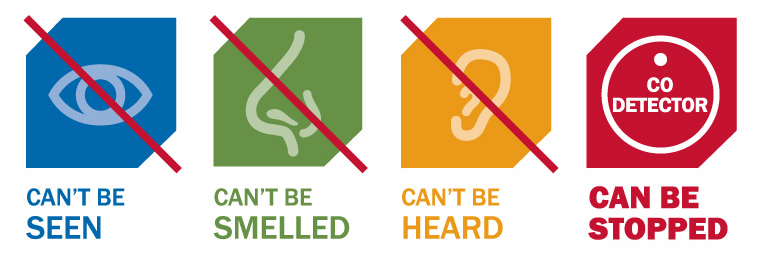Carbon Monoxide Poisoning - Safety
Carbon Monoxide:
The Silent Killer

Additional Resources:
What is carbon monoxide?
Carbon monoxide is colorless, odorless, and tasteless, but highly toxic.
Carbon monoxide (CO) poisoning is the leading cause of poison-related death in the United States and is responsible for approximately 450 deaths and 20,000 nonfatal injuries every year. Poisoning occurs when CO escapes from fuel-burning appliances and becomes trapped in enclosed spaces.
Within the United States, faulty furnaces and motor vehicles are the leading cause of CO poisoning and death, respectively. Most unintentional poisonings (64 percent) occur in homes or other residences, and a smaller percentage (21 percent to 23 percent) occurs in occupational settings or other public areas.
Symptoms of CO Poisoning:
Because CO is odorless, colorless, and otherwise undetectable to the human senses, people may not know that they are being exposed. The initial symptoms of low to moderate CO poisoning are similar to the flu (but without the fever).
Low level Symptoms include:
- Headache
- Fatigue
- Shortness of breath
- Nausea
- Dizziness
High level CO poisoning results in progressively more severe symptoms, including:
- Mental confusion
- Vomiting
- Loss of muscular coordination
- Loss of consciousness
- Ultimately death
Play it Safe - If you experience symptoms that you think could be from CO poisoning:
- CALL 911 or your local emergency number.
- GET FRESH AIR IMMEDIATELY. Open doors and windows, turn off combustion appliances and leave the house.
- DO NOT re-enter the premises until cleared by emergency personnel.
- GO TO AN EMERGENCY ROOM and tell the physician you suspect CO poisoning. If CO poisoning has occurred, it can often be diagnosed by a blood test done soon after exposure.
Install battery-operated CO detectors in the home!
Install CO alarms outside each sleeping area and on every level of the home including the basement. The CO alarm can warn you if too much CO is in your home but only when they are operable. Check the batteries every six months and replace the batteries every year. Keep CO alarms clear of dust and debris.
*Note* In California all homes are required to have carbon monoxide detectors installed (Ref: Senate Bill - SB 183)
CO Poisoning Prevention:
The risks of CO Poisoning can be greatly reduced by following these Do's and Dont's:
-
DO have your fuel-burning appliances -- including oil and gas furnaces, gas water heaters, gas ranges and ovens, gas dryers, gas or kerosene space heaters, fireplaces, and wood stoves - inspected by a trained professional at the beginning of every heating season. Make certain that the flues and chimneys are connected, in good condition, and not blocked.
-
DO choose appliances that vent their fumes to the outside whenever possible, have them properly installed, and maintain them according to manufacturers' instructions.
-
DO read and follow all of the instructions that accompany any fuel-burning device. If you cannot avoid using an unvented gas or kerosene space heater, carefully follow the cautions that come with the device and keep doors to the rest of the house open. Crack a window to ensure enough air for ventilation and proper fuel-burning.
-
DON'T idle the car in a garage -- even if the garage door to the outside is open. Fumes can build up very quickly in the garage and living area of your home.
-
DON'T use a gas oven to heat your home, even for a short time.
-
DON'T ever use a charcoal grill indoors -- even in a fireplace.
-
DON'T sleep in any room with an unvented gas or kerosene space heater.
-
DON'T use any gasoline-powered engines (mowers, weed trimmers, snow blowers, chain saws, small engines or generators) in enclosed spaces.
-
DON'T ignore symptoms, particularly if more than one person is feeling them. You could lose consciousness and die if you do nothing.

